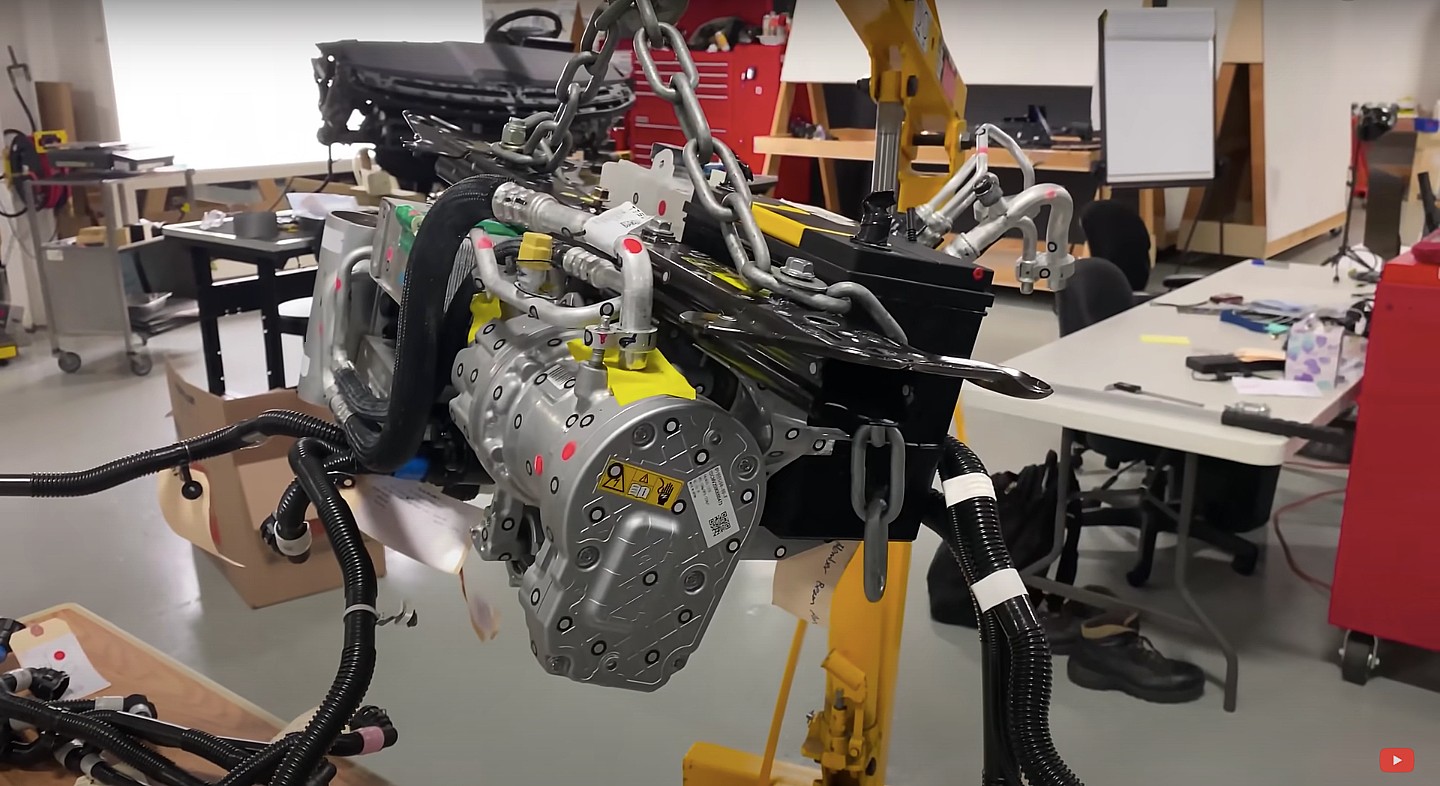

News
Tesla’s sustainability focus is evident down to the Model Y’s thermal system
It is no secret that Tesla’s main focus revolves around sustainability. Its mission is to accelerate the advent of sustainable energy, which is one of the reasons why every vehicle the company releases is designed to be a preferable alternative to cars powered by the internal combustion engine. This point became especially evident recently when the Model Y’s thermal system was compared side-by-side to that of the Ford Mustang Mach-E.
As discussed by automotive teardown expert Sandy Munro in his Munro Live YouTube channel, the Tesla Model Y’s thermal system is quite a feat in first-principles thinking and engineering. This could be seen in custom-designed components such as the Octovalve, as well as the hoses that Tesla used for the system. Munro noted that overall, the Model Y’s thermal system only uses 10 hoses with a total length of 6.35 meters, which is very conservative compared to other electric vehicles in the market.
Munro and Associates is currently in the process of tearing down the Ford Mustang Mach-E, and one of the things that caught the team’s attention was the all-electric crossover’s thermal system, which the automotive veteran candidly dubbed as a “nightmare.” This “nightmare” was represented by the lengthy, twisted cacophony of hoses that Ford used for its all-electric crossover’s thermal system. Compared to the Model Y, the Mach-E uses 250% more parts, which likely makes the vehicle more costly to build.
The teardown team found that the Mustang Mach-E’s thermal system had a total part count of 35 pieces, and the total length of its hoses stood at 18.42 meters, over two times longer than the hoses used in the Model Y. The fluids in the Model Y are significantly less than those used in the Mustang Mach-E as well, though they essentially play the same role.
As noted by members of the electric vehicle community who are familiar with thermal systems, the Mach-E also uses conventional rubber coolant hoses, which are generally heavy and not easy to recycle. These rubber hoses are very cheap, however, despite the fact that they require a lot of energy to manufacture. In contrast, Tesla appears to be using nylon materials for the Model Y’s tubing, which is more recyclable and more energy efficient to produce. Nylon tubing is significantly lighter than the rubber hoses used in the Mach-E, but it is several times more expensive.
Munro and Associates only showed a glimpse of the engineering prowess displayed by Tesla team when it designed the Model Y, but one thing was immediately evident when the all-electric crossover’s thermal system was compared to the Mach-E. The Tesla Model Y is created from the ground up to be a vehicle that’s designed for a renewable future, and its components seem to have been selected with sustainability in mind. The Model Y’s nylon hoses, which are more expensive but more sustainable, seem to be part of this strategy.
Tesla’s experience in building electric vehicles is evident in the Model Y’s components. Veterans like Ford, on the other hand, seem to still be learning the ropes. But this is not the most thought-provoking conclusion from Munro’s comparison of the Model Y and Mach-E’s thermal system. While the Tesla is miles ahead, Munro emphasized that the Ford Mustang Mach-E is already the best non-Tesla electric car that they have torn down and analyzed to date.
Watch Munro’s comparison of the Tesla Model Y and Ford Mustang Mach-E’s thermal system below.
Don’t hesitate to contact us with news tips. Just send a message to tips@teslarati.com to give us a heads up.
News
Tesla cleared in Canada EV rebate investigation
Tesla has been cleared in an investigation into the company’s staggering number of EV rebate claims in Canada in January.

Canadian officials have cleared Tesla following an investigation into a large number of claims submitted to the country’s electric vehicle (EV) rebates earlier this year.
Transport Canada has ruled that there was no evidence of fraud after Tesla submitted 8,653 EV rebate claims for the country’s Incentives for Zero-Emission Vehicles (iZEV) program, as detailed in a report on Friday from The Globe and Mail. Despite the huge number of claims, Canadian authorities have found that the figure represented vehicles that had been delivered prior to the submission deadline for the program.
According to Transport Minister Chrystia Freeland, the claims “were determined to legitimately represent cars sold before January 12,” which was the final day for OEMs to submit these claims before the government suspended the program.
Upon initial reporting of the Tesla claims submitted in January, it was estimated that they were valued at around $43 million. In March, Freeland and Transport Canada opened the investigation into Tesla, noting that they would be freezing the rebate payments until the claims were found to be valid.
READ MORE ON ELECTRIC VEHICLES: EVs getting cleaner more quickly than expected in Europe: study
Huw Williams, Canadian Automobile Dealers Association Public Affairs Director, accepted the results of the investigation, while also questioning how Tesla knew to submit the claims that weekend, just before the program ran out.
“I think there’s a larger question as to how Tesla knew to run those through on that weekend,” Williams said. “It doesn’t appear to me that we have an investigation into any communication between Transport Canada and Tesla, between officials who may have shared information inappropriately.”
Tesla sales have been down in Canada for the first half of this year, amidst turmoil between the country and the Trump administration’s tariffs. Although Elon Musk has since stepped back from his role with the administration, a number of companies and officials in Canada were calling for a boycott of Tesla’s vehicles earlier this year, due in part to his association with Trump.
News
Tesla Semis to get 18 new Megachargers at this PepsiCo plant
PepsiCo is set to add more Tesla Semi Megachargers, this time at a facility in North Carolina.

Tesla partner PepsiCo is set to build new Semi charging stations at one of its manufacturing sites, as revealed in new permitting plans shared this week.
On Friday, Tesla charging station scout MarcoRP shared plans on X for 18 Semi Megacharging stalls at PepsiCo’s facility in Charlotte, North Carolina, coming as the latest update plans for the company’s increasingly electrified fleet. The stalls are set to be built side by side, along with three Tesla Megapack grid-scale battery systems.
The plans also note the faster charging speeds for the chargers, which can charge the Class 8 Semi at speeds of up to 1MW. Tesla says that the speed can charge the Semi back to roughly 70 percent in around 30 minutes.
You can see the site plans for the PepsiCo North Carolina Megacharger below.

Credit: PepsiCo (via MarcoRPi1 on X)

Credit: PepsiCo (via MarcoRPi1 on X)
READ MORE ON THE TESLA SEMI: Tesla to build Semi Megacharger station in Southern California
PepsiCo’s Tesla Semi fleet, other Megachargers, and initial tests and deliveries
PepsiCo was the first external customer to take delivery of Tesla’s Semis back in 2023, starting with just an initial order of 15. Since then, the company has continued to expand the fleet, recently taking delivery of an additional 50 units in California. The PepsiCo fleet was up to around 86 units as of last year, according to statements from Semi Senior Manager Dan Priestley.
Additionally, the company has similar Megachargers at its facilities in Modesto, Sacramento, and Fresno, California, and Tesla also submitted plans for approval to build 12 new Megacharging stalls in Los Angeles County.
Over the past couple of years, Tesla has also been delivering the electric Class 8 units to a number of other companies for pilot programs, and Priestley shared some results from PepsiCo’s initial Semi tests last year. Notably, the executive spoke with a handful of PepsiCo workers who said they really liked the Semi and wouldn’t plan on going back to diesel trucks.
The company is also nearing completion of a higher-volume Semi plant at its Gigafactory in Nevada, which is expected to eventually have an annual production capacity of 50,000 Semi units.
Tesla executive teases plan to further electrify supply chain
News
Tesla sales soar in Norway with new Model Y leading the charge
Tesla recorded a 54% year-over-year jump in new vehicle registrations in June.

Tesla is seeing strong momentum in Norway, with sales of the new Model Y helping the company maintain dominance in one of the world’s most electric vehicle-friendly markets.
Model Y upgrades and consumer preferences
According to the Norwegian Road Federation (OFV), Tesla recorded a 54% year-over-year jump in new vehicle registrations in June. The Model Y led the charge, posting a 115% increase compared to the same period last year. Tesla Norway’s growth was even more notable in May, with sales surging a whopping 213%, as noted in a CNBC report.
Christina Bu, secretary general of the Norwegian EV Association (NEVA), stated that Tesla’s strong market performance was partly due to the updated Model Y, which is really just a good car, period.
“I think it just has to do with the fact that they deliver a car which has quite a lot of value for money and is what Norwegians need. What Norwegians need, a large luggage space, all wheel drive, and a tow hitch, high ground clearance as well. In addition, quite good digital solutions which people have gotten used to, and also a charging network,” she said.
Tesla in Europe
Tesla’s success in Norway is supported by long-standing government incentives for EV adoption, including exemptions from VAT, road toll discounts, and access to bus lanes. Public and home charging infrastructure is also widely available, making the EV ownership experience in the country very convenient.
Tesla’s performance in Europe is still a mixed bag, with markets like Germany and France still seeing declines in recent months. In areas such as Norway, Spain, and Portugal, however, Tesla’s new car registrations are rising. Spain’s sales rose 61% and Portugal’s sales rose 7% last month. This suggests that regional demand may be stabilizing or rebounding in pockets of Europe.
-

 Elon Musk2 weeks ago
Elon Musk2 weeks agoTesla investors will be shocked by Jim Cramer’s latest assessment
-

 Elon Musk2 days ago
Elon Musk2 days agoxAI launches Grok 4 with new $300/month SuperGrok Heavy subscription
-

 Elon Musk4 days ago
Elon Musk4 days agoElon Musk confirms Grok 4 launch on July 9 with livestream event
-

 News1 week ago
News1 week agoTesla Model 3 ranks as the safest new car in Europe for 2025, per Euro NCAP tests
-

 Elon Musk2 weeks ago
Elon Musk2 weeks agoA Tesla just delivered itself to a customer autonomously, Elon Musk confirms
-

 Elon Musk1 week ago
Elon Musk1 week agoxAI’s Memphis data center receives air permit despite community criticism
-

 News2 weeks ago
News2 weeks agoXiaomi CEO congratulates Tesla on first FSD delivery: “We have to continue learning!”
-

 News2 weeks ago
News2 weeks agoTesla sees explosive sales growth in UK, Spain, and Netherlands in June
















